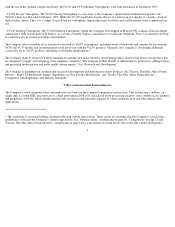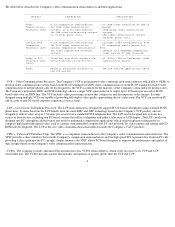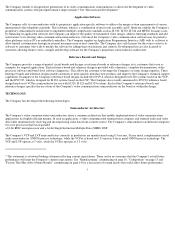8x8 1998 Annual Report Download - page 19
Download and view the complete annual report
Please find page 19 of the 1998 8x8 annual report below. You can navigate through the pages in the report by either clicking on the pages listed below, or by using the keyword search tool below to find specific information within the annual report.not limited to: changes in market demand, the timing of customer orders, competitive market conditions, lengthy sales cycles, regulatory
approval cycles, new product introductions by the Company or its competitors, market acceptance of new or existing products, the cost and
availability of components, the mix of the Company's customer base and sales channels, the mix of products sold, the management of inventory
and the accuracy of the reporting of sell-through by resellers of the Company's products, the level of international sales, continued compliance
with industry standards and general economic conditions.
The Company's gross margin is affected by a number of factors including product mix, the recognition of license and other revenues for which
there may be no or little corresponding cost of revenues, product pricing, the allocation between international and domestic sales, the
percentage of direct sales and sales to resellers, and manufacturing and component costs. The markets for the Company's products are
characterized by falling average selling prices. The Company expects that, as a result of competitive pressures and other factors, gross profit as
a percentage of revenue for the Company's semiconductor products will likely decrease for the foreseeable future. In addition, the gross
margins for the Company's VideoComunicators are, and will continue to be, substantially lower than the gross margins for its semiconductors.
Thus, the growth of the Company's VideoCommunicator business has reduced overall product gross profit as a percentage of revenue.
Continued growth of the Company's VideoCommunicator business relative to its semiconductor business will result in a further reduction in
product gross profit as a percentage of revenue.
If the Company cannot adequately compensate for falling average selling prices with lower costs of sales, its gross margins will be reduced and
there may be a material adverse effect on the Company's business and operating results. In the event that the Company encounters significant
price competition in the markets for its products, the Company could be at a significant disadvantage compared to its competitors, many of
which have substantially greater resources, and therefore may be better able to withstand an extended period of downward pricing pressure.
Variations in timing of sales may cause significant fluctuations in future operating results. In addition, because a significant portion of the
Company's business, including sales of its VideoCommunicator products, may be derived from orders placed by a limited number of large
customers, including OEM customers, the timing of such orders can also cause significant fluctuations in the Company's operating results. For
example, 3Com, which purchased approximately 34% of videophone systems sold by the Company in the year ended March 31, 1998, has not
ordered additional products from the Company since delivery of its purchases in the quarter ended December 31, 1998. Anticipated orders from
customers may fail to materialize. Delivery schedules may be deferred or canceled for a number of reasons, including changes in specific
customer requirements or international economic conditions. The adverse impact of a shortfall in the Company's revenues may be magnified by
the Company's inability to adjust spending to compensate for such shortfall. Announcements by the Company or its competitors of new
products and technologies could cause customers to defer purchases of the Company's existing products, which would also have a material
adverse effect on the Company's business and operating results.
The Company's products have lead times of up to four months, and are built to forecasts that are necessarily imperfect, particularly given the
early stage of the videophone market. Because of the Company's practice of building its products to necessarily imprecise forecasts, it is likely
that, from time to time, the Company will have either excess or insufficient product inventory. This risk is heightened because of the need for
and presence of significant VideoCommunicator inventory in retail distribution. Further, because retailers and other distributors may have
significant quantities of VideoCommunicator inventory on hand and generally have contractual rights to price protection if the Company
decreases the selling price, in the event of a significant price decrease, the Company's cost of such inventory may exceed the Company's actual
selling price. Excess inventory levels will subject the Company to the risk of inventory obsolescence and the risk that the Company's selling
prices may drop below the Company's inventory costs, while insufficient levels of inventory may negatively affect relations with customers.
Any of these factors could have a material adverse effect on the Company's operating results and business.
The Company's introduction of VideoCommunicators has resulted in substantially different patterns in operating results. For example, during
fiscal 1998, the Company's operating results were subject to increased
15
























